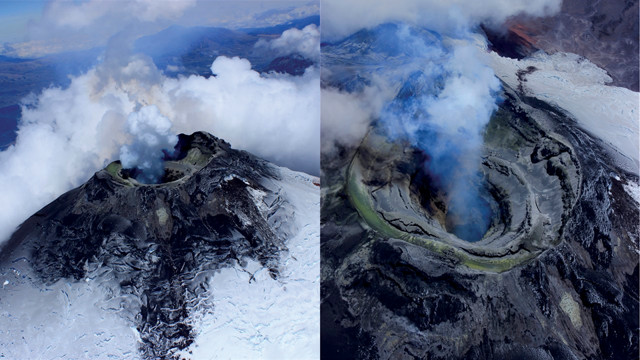
by Mary Caperton Morton Monday, September 10, 2018

The once-visible floor of Cotopaxi's summit crater dropped out of sight after the 2015 eruptions. Credit: both: Silvia Vallejo Vargas/Instituto Geofisico, Escuela Politécnica Nacional.
An active volcano in central Ecuador may be the largest musical instrument on Earth: After eruptions in 2015, Cotopaxi’s newly configured crater started emitting distinctly musical rumblings that scientists may be able to use to monitor future activity at the volcano.
After nearly a century of silence, Cotopaxi erupted in 2015 in a series of minor explosions, one of which triggered a collapse of the crater’s floor. Soon afterward, geophysical instruments started picking up unique sounds from the volcano, too low for human ears to hear. The oscillating soundwaves would last about 90 seconds before fading. Researchers dubbed the sounds “tornillos,” Spanish for screws, because the sound waves resemble screw threads and describe the noise as a slowly swinging creaky door.
For the first half of 2016, the tornillos occurred roughly once a day, then they stopped. Scientists are unsure how the sounds were created, but each tornillo was accompanied by a rush of gas through the volcano’s summit vent. And in a new study in Geophysical Research Letters, they liken the effect to a pipe organ, which creates similar low frequency sounds by forcing air through pipes of varying lengths. “It’s a beautiful signal and amazing that the natural world is able to produce this type of oscillation,” said Jeff Johnson, a volcanologist at Boise State University in Idaho and lead author of the study, in a statement.
Active volcanoes are known to make odd noises before, during and after eruptions, and understanding an individual volcano’s unique voiceprint can help scientists track how magma is moving through the system. “Once you realize how a volcano sounds, if there are changes to that sound, that leads us to think there are changes going on … and that causes us to pay attention,” Johnson said.
© 2008-2021. All rights reserved. Any copying, redistribution or retransmission of any of the contents of this service without the expressed written permission of the American Geosciences Institute is expressly prohibited. Click here for all copyright requests.